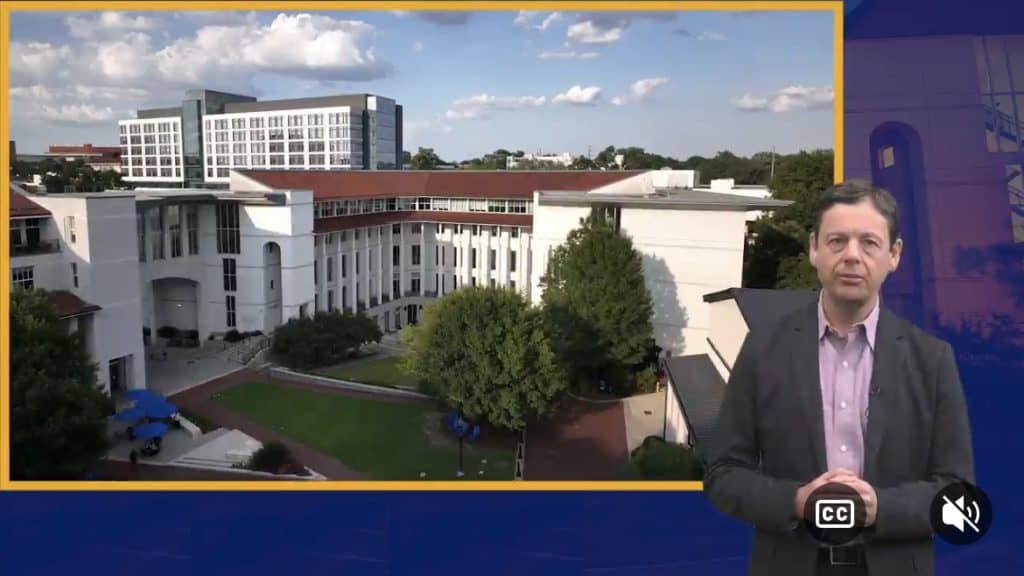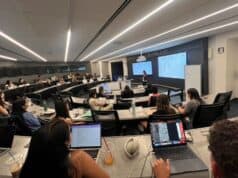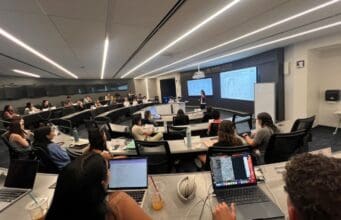The following article was originally published by AACSB.
Emory University’s Goizueta Business School offers insights into why and how we can use artificial intelligence to deliver educational content.
- + Early technological interventions can improve student outcomes, as long as human instructors are also involved.
- + Material that is delivered by AI tools can be quickly and easily updated. It also can be customized to provide more personalized learning experiences.
- + Many professors aren’t familiar with AI tools—and students are. So, schools need to encourage collaboration and provide support to faculty who want to experiment with the technology.
How would business education change if all instructors were assisted by avatars—virtual doppelgängers that look and sound just like them? More broadly, how would it affect student learning if every classroom included an artificial intelligence (AI) component?
The possibilities seem endless. When AI instructors are part of the classroom experience, it opens doors to many possibilities. Schools can deliver content in multiple languages, create hyper-personalized learning experiences, and easily update program materials. But how does an avatar’s communication of material compare to that of a human instructor?

To answer that question, Goizueta Business School at Emory University in Atlanta is exploring the best ways to deliver education through avatars, AI, and other developing technologies. Driven by curiosity, faculty and staff members are building on lessons learned during COVID-19, when curricula had to be adapted for online learning.
“In four or five years, AI technology will exponentially change. So, it’s up to us to embrace a more collaborative, technology-enabled education model,” says Gareth James, the John H. Harland Dean of Goizueta Business School and an expert on statistical and machine learning methodologies. He notes that faculty who use AI are not merely standing at the front of the classroom, presenting knowledge. They’re also learning from students, “because many students are independently learning about this technology.”
Through these collaborative efforts, Goizueta’s faculty and staff have developed five key insights about why and how to use AI in the classroom.
1. AI Can Improve Student Outcomes
Rajiv Garg wondered how the presence of human and AI instructors might affect student performance—whether separate or in some combination. An associate professor of information systems and operations management, Garg worked with student researchers to set up a small study. He and his team assigned 40 students to classes taught by a human, an AI system, or both.

The students who performed best on the final exam had learned with human-generated course content guided by an AI voice/avatar. The second-best performers learned from the completely human-generated course. Those in the completely AI-generated course did less well. The poorest-performing students were those in the AI-generated course led by a human voice/avatar.
Garg and his students are expanding this small-scale experiment this semester. So far, it suggests that a faculty expert still does a better job of generating a course than an AI system does. But an AI assistant or avatar can deliver content successfully. This means schools can save both time and money by having human experts generate new content and avatars deliver it. James says, “You could certainly imagine getting the best of both worlds: great research and great presentation skills.”
To create AI assistants, professors first design avatars that are similar to themselves in appearances, voices, accents, and mannerisms. After professors feed scripts to the AI system, their avatars deliver the content in the form of videos. They can then use this content to supplement classroom teaching.
A faculty expert still does a better job of generating a course than an AI system does. But an AI assistant or avatar can deliver content successfully.
Garg encourages academics to be thoughtful in the material they provide to their virtual assistants. That’s because the AI is learning from all the content it consumes, and better inputs lead to more useful outputs. He also suggests that professors continually tweak the material the AI is using. Otherwise, both the avatar and the content could become stale and ineffective.
Creating an AI assistant is “not just a switch that you flip,” he warns. “You may be innovating content a dozen times in a semester to make sure the content is achieving the task of teaching students.”
2. AI Enables Quick Course Updates
AI is raising societal expectations that all deliverables—just like Amazon boxes—will arrive immediately. With the help of AI, faculty can swiftly create new material that reflects breaking changes across industries, explains Pam Tipton, Goizueta Business School’s senior director of custom executive education programs.
This flexibility is particularly useful for schools that offer customized education courses. Such programs often are delivered on demand to C-suite leaders in industries that are rapidly changing—sometimes because of AI itself. Many of Goizueta’s executive education participants come from Atlanta, a metro area of 5 million people that is home to 17 Fortune 500 company headquarters. AI allows professors to swiftly create and incorporate “new case studies, especially from within an executive’s own company,” Tipton says.
Her advice to professors who are unfamiliar with AI: Try a small experiment with free tools. “Set up free accounts and see what the output looks and feels like,” Tipton advises. “Play around in small ways to integrate AI into your classroom. When you experiment, you’ll find the AI tools that work for you and your clients.”
3. Faculty Need Support to Try AI
Stephanie Adams initially gulped at the disruption posed by AI. As the senior associate director of academic affairs and instructional design at Goizueta Business School, she supports faculty and students by helping them optimize their working relationships. While she knows AI presents growth opportunities in educational applications, she realizes that the learning curve can be steep for professors unfamiliar with the technology. She recommends that administrators provide accessible paths that encourage professors to try AI.
“We have folks who embrace innovation and technologies and folks who are more fearful, skeptical,” she says. “It’s important to build a space where they feel comfortable learning new things, comfortable exploring, and okay when something doesn’t work.”
Goizueta faculty have learned to use AI to develop slide decks, organize syllabi and course content, generate ideas, and comb through data. They also have discovered that some AI tools are better for text, while others are better for images or data. “When faculty feel empowered, it impacts learners in a positive way,” says Adams.
AI presents growth opportunities in educational applications, but the learning curve can be steep for professors unfamiliar with the technology.
The school held a gathering that allowed faculty and staff to share their AI experiences and teaching strategies. Adams particularly likes the scavenger hunt that a faculty member created using free AI tools. “There is an online link with a small prompt that helps professors learn to use the tool in a very basic way,” she says. “A scavenger hunt can be a brilliant, low-stakes way to learn and build confidence with AI.”
She adds, “Adapting to AI is a lot about teaching and learning with curiosity, because we’re never going to dip our toes in the water and learn something new if we let our fears hold us back.”
4. Students Must Learn the Ethics of AI
While faculty might find it difficult to master AI, many learners are already familiar with it. However, it’s often up to the school to ensure that students use the new technology in an ethical fashion.
“We don’t want students to violate the honor code. We want to uphold the integrity of our work,” says Adams. She believes it’s essential for the business school community to discuss its standards and agree upon best practices and guidelines for using AI.
“Rather than saying, ‘This AI tool is banned in my class,’ faculty could consider saying, ‘Let’s use this tool and really explore it,’” Adams suggests. Professors could have AI respond to a problem, then ask students to analyze its responses. What did it get right? Where did it go wrong? Students will learn not only how to use AI language models, Adams emphasizes, but also how to think critically.
Karl Kuhnert is one of the Goizueta professors who is exploring how AI can support ethical decision-making in the classroom and beyond. Using sophisticated AI software, he is “cloning” leading experts. To do this, he uses their judgment, intuition, and experience to create their digital twins. The resulting tools help individuals learn how to make subjective, time-critical, high-consequence decisions. It’s particularly useful in complex industries such as healthcare and insurance. For instance, doctors can use AI tools to determine whether or not to prescribe new weight-loss drugs such as Ozempic.
5. Be Strategic—But Have Fun.

Tinkering has its roots in play, and Goizueta Business School channeled some whimsy—and generated some buzz—by creating an avatar of its top leader. “Digi-Dean” stars in a brief social media video about how the school’s leadership is applying AI to business education.
“Emory may no longer need my services,” laments James, who is originally from New Zealand, in a post about his digital alter ego. “Anyone need a slightly used dean with an exotic accent?”
AI gives business schools another tool to expand their global reach, drive meaningful classroom exchanges with students, and respond to daily market changes.
More seriously, Goizueta faculty and administrators identify many benefits of using AI in the classroom:
- + Avatars allow schools to provide highly personalized education at a lower cost per student. For instance, faculty can use avatars to deliver content in any language to students from anywhere in the world.
- + Using AI, schools can customize core business courses for specific industries such as finance, real estate, healthcare, and technology.
- + If a professor leaves an institution, the school can use an avatar service to easily re-edit and rerecord supplemental materials.
Preparing for the Future
Today’s business schools are constantly seeking to expand their global reach, drive meaningful classroom exchanges with students, and respond to daily market changes. AI gives them another tool to achieve these goals.
In addition, when schools incorporate AI into the classroom, they are preparing students for the future. Goizueta’s namesake, former Coca-Cola CEO Robert C. Goizueta, put it this way: “Business schools today cannot just reflect business the way it is. They must teach business the way it will be.”
It’s clear that businesses will be relying heavily on new technology to support their future planning and growth. Business schools must adapt their educational approaches accordingly.
Goizueta’s teaching innovations have transformed the traditional classroom into a dynamic digital ecosystem with virtual reality (VR), augmented reality (AR), artificial intelligence (AI), and holographic capabilities. Learn more about our unparalleled educational experience with unparalleled results.










